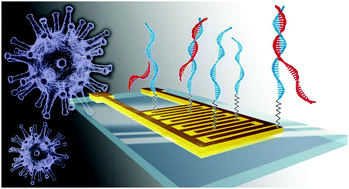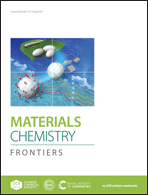Detection of a SARS-CoV-2 sequence with genosensors using data analysis based on information visualization and machine learning techniques†
Abstract
We report on genosensors to detect an ssDNA sequence from the SARS-CoV-2 genome, which mimics the GU280 gp10 gene (coding the viral nucleocapsid phosphoprotein), using four distinct principles of detection and treating the data with information visualization and machine learning techniques. Genosensors were fabricated on either gold (Au) interdigitated electrodes for electrical and electrochemical measurements or on Au nanoparticles on a glass slide for optical measurements. They contained a matrix of 11-mercaptoundecanoic acid (11-MUA) self-assembled monolayer (SAM) onto which a layer of capture probe (cpDNA) sequence was immobilized. Detection was performed using electrical and electrochemical impedance spectroscopies and localized surface plasmon resonance (LSPR). The highest sensitivity was reached with impedance spectroscopy, including using a low-cost (US$ 100) homemade impedance analyzer. Complementary ssDNA sequences were detected with a detection limit of 0.5 aM (0.3 copy per µL). This performance may be attributed to the high sensitivity of the electrical impedance technique combined with an appropriate arrangement of the sequences on the electrodes and hybridization between the complementary sequences, as inferred from polarization-modulated infrared reflection absorption spectroscopy (PM-IRRAS). The selectivity of the genosensor was confirmed by plotting the impedance spectroscopy data with a multidimensional projection technique (interactive document mapping, IDMAP), where a clear separation was observed among the samples of the complementary DNA sequence at various concentrations and from buffer samples containing a non-complementary sequence and other DNA biomarkers. The diagnosis of SARS-CoV-2 mimicking sequences was also achieved with machine learning techniques applied to scanning electron microscope images taken from genosensors exposed to distinct concentrations of the complementary ssDNA sequences. In summary, the genosensors proposed here are promising for detecting SARS-CoV-2 genetic material (RNA) in biological fluids in point-of-care settings.

- This article is part of the themed collection: Celebrating Latin American Chemistry


 Please wait while we load your content...
Please wait while we load your content...